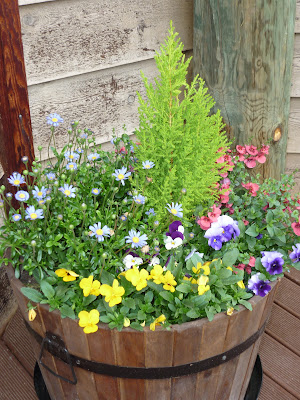The garden announces festive cheer
I take a walk around the garden and I can see the colours of Christmas all around - right on cue, as if the plants know exactly when to start their display for the festive season.
The New Zealand Christmas bush is bursting with superb red and white flowers - it truly lives up to its name as the flowers appear like Christmas decorations all over the bush. What a sight! A ready made Australian Christmas tree - a gift from nature.
Red is everywhere in the garden, not only is it my favourite colour, but it's perfect for the festive season and marks the beginning of summer. I've placed three pots of bright red geraniums below the stairwell so when I go into the garage and garden they are the first to greet me with their bright and happy colour.
The berries are also out like little red beacons in the greenery. Although there are only a few plants at present, they still produce enough berries for a daily taste of raspberries, red currents and strawberries. My favourites are the tiny alpine strawberries. They are so flavoursome, the taste is so strong and resembles sherbet lollies rather than the traditional large strawberry. I will definitely need to plant many more berry bushes next year as it has been wonderful each day to wonder into the garden and pick the fruit straight from the bush. The regular strawberries are the only ones not to have produced as expected. Many are eaten by bugs before they fully ripen so now I pick the strawberries just before that point and finish to ripen them on the kitchen bench. I will need to find out what to do about that. Anyone has any suggestions?
The satisfaction is that you can go from that.....
To this.... a scrumptious summer berry tart!
The rainbow silver beet is also showing off its colours for the festive season.
It's quite amazing to see that the initial plantings are doing so well. I guess plants aren't that dissimilar to people: they need food, water, care and attention to hopefully lead a healthy life.
That said, the only red not to appear in the garden this summer, to my great disappointment, is that of cherries. The two cherry trees have been attacked by cherry slug. A disaster, as cherries are also a favourite of mine. Early in the season I sprayed the cherries to no avail, the slugs returned. I have waged war on the little buggers and although have fought numerous fortnightly battles with Eco-sprays, there are still a few eating away at the tips of the branches. Albeit slowly, I am gradually defeating the slugs as one tree is now clear of any pests. However, this year the loss has been heavy and there are no cherries even though the trees flowered quite prolifically. Any helpful advice on how to deal with cherry slugs is welcomed.
Oh well, means this year I will have to find a local grower and visit a cherry farm to get my cherries.



















